

CHRISTIAN LEADER








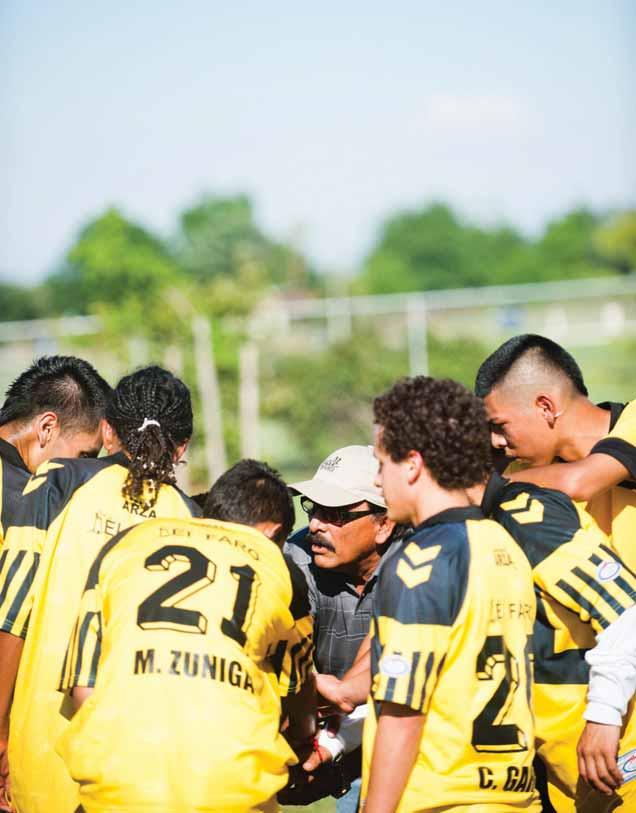


One of our goals in publishing this magazine is that readers will be encouraged to be involved in the lives of others so that individuals, families and communities will be changed completely for the better thanks to the transforming work of Jesus Christ. And one of the ways that we offer this encouragement is by sharing stories of people who are serving others.
Sometimes the story focuses on ministry within God’s family. Just because we are followers of Jesus Christ doesn’t mean our lives are perfect—Christians need to be served, loved and cared for just like anyone else. Other times CL articles highlight Mennonite Brethren who are investing themselves in those who have not yet declared their allegiance to King Jesus.
Many times we focus on positive outcomes—the lives that have been changed and stories of success. But getting close to another person—a fellow believer or someone still searching—is easier said than done.
Being involved in the lives of nearly two dozen teenage boys is no doubt one of those easier-saidthan-done acts of service.
“ “

Connie Faber Editor
It can be inconvenient and risky. Investing ourselves in others can ask more of us than we think we are prepared to give. It can stretch our financial and emotional resources. Hugging someone who smells bad or who has a contagious illness may require some resolve and determination. So can spending less time on established friendships in order to nurture a new relationship with someone with whom you have little in common but who you feel God is asking you to befriend.
In this issue we tell the story of the El Faro soccer team (pp. 17-18.) The opportunity to invest themselves in nearly two dozen teenage boys was an answer to prayer, Ricardo Biberos told a reporter from the Reedley (Calif.) Exponent last year when the newspaper interviewed members of the church involved with the soccer team. Just eight months after forming the team, coaches could see the teens changing for the better.
But it can’t have been easy to earn the trust and friendship of these bored troublemakers, familiar with gangs and drugs. There likely were some “messy” moments as the adults and teens formed the comfortable relationships they came to enjoy. Being involved in the lives of nearly two dozen teenage boys is no doubt one of those easier-said-than-done acts of service.
Yes, there are rewarding highs when we serve others, and it’s good to celebrate the ways in which God uses us to bring about change in someone’s life. There are also discouraging lows. This stuff—the tough reality of what it means to give yourself to someone else—can be hard to share. But it’s an important part of ministry, a valuable thing to share as we encourage one another as servants of Jesus Christ and his church.
ANDREW SHINN












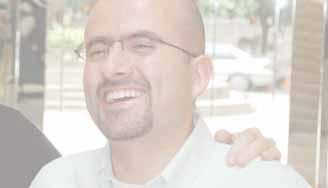


byTheBook
Steve Schroeder

Raising the bar
As one of the taller kids in junior high school, I thought I would be good at high jump. So I set up some posts in my backyard, hammered in some nails and found a stick that was long enough to rest on those nails. Then the challenge began. How high could I jump? I soon learned that landing on the lawn was painful. So I transitioned to practicing at school where we had a real high jump pit complete with soft landing pads.
The objective in high jump is simple—to see who can jump the highest by raising the bar one notch at a time. When we look at the way Jesus approaches Old Testament laws, we find him “raising the bar” with respect to morality and keeping the law. He sets the stage for this in Matthew 5:20 where he speaks about having a righteousness that “surpasses that of the Pharisees.” That’s really raising the bar! They already had such high standards. What could be higher than that?
But Jesus does not add more laws. He redefines familiar Old Testament laws in a way that calls for right motives that will inevitably result in a higher standard of conduct. For example, the law says that a murderer is subject to judgment (Matt. 5:21). Jesus raises that bar to a new level, saying, “Anyone who is angry with his brother will be subject to judgment” (v. 22). For Jesus it was not simply a matter of making sure you don’t get so mad that you end up killing your brother. Rather, his standard forced a serious look at the heart: Why do I get angry with my brother in the first place?
He does the same thing with the law concerning adultery. For Jesus it is not just a matter of making sure that in our lusting we don’t actually commit adultery. He raises the bar by suggesting that we not even allow our eyes to desire someone.
We see this new kind of standard again when Jesus rejects the idea of casual divorce (simply filling out the right paperwork) and casual promises (you’re only obligated to keep your word if you swore by God when you made that promise). Jesus’ new way of living invites us to guard our mouths and say only what we mean. He challenges us to take our marriage vows seriously without looking for an easy out. He calls us to take the high road of guarding our hearts, our eyes and our minds long before we end up committing adultery or murder.
So instead of raising the bar so high that everyone is disqualified, Jesus raises the bar in order to make it clear that apart from his heart-transforming power we’ll never be able to jump that high.

CHRISTIAN LEADER
August / September 2011 Volume 74 • Number 4
Connie Faber EDITOR
Myra Holmes ASSISTANT EDITOR
Shelley Plett GRAPHIC DESIGNER
Andrew Shinn COVER PHOTO
The Christian Leader (ISSN 0009-5149) is a gathering place for the people, passions and mission of U.S Mennonite Brethren. The Christian Leader is published bimonthly by the U.S. Conference of Mennonite Brethren Churches. However, the opinions expressed here are not necessarily those of the church as a whole.
COPYRIGHT The articles printed in the Christian Leader are owned by the CL or by the author and may not be reprinted without permission. Unless noted, Scripture quotations are from the New International Version.
READER PARTICIPATION Letters to the editor should be 300 words or less and on one subject. Letters must be signed and include the writer’s city and state. Letters will be edited for clarity, appropriateness and length. Letters will be published, as space allows, unless marked, “Not for publication.” Readers interested in contributing essays for In My Humble Opinion and First Person should contact the editor. Freelance article submissions are welcome; a SASE must accompany articles.
SUBSCRIPTIONS $10 for six issues and $20 for 12 issues ($15, $30 in Canada; all other countries $25 for six issues); $1.50 per copy
CORRESPONDENCE: All correspondence, including subscription questions and address updates, should be addressed to Christian Leader
Box 155, 107 N. Main, Hillsboro, KS 67063-0155 Phone: 620.947.5543
E-mail: christianleader@usmb.org
MEMBERSHIP The Christian Leader is a member of the Evangelical Press Association and Meetinghouse, an association of Mennonite and Brethren in Christ editors.
POSTMASTER Send address changes to Christian Leader, Box 155, Hillsboro, KS 67063. Periodicals postage paid at Hillsboro, Kansas.
The Christian Leader is published by
“But I tell you that anyone who is angry with his brother will be subject to judgment.” ~ Matt. 5:22

U.S. Conference of MB Churches

Ed Boschman USMB Executive Director ebed@usmb.org
Grown-up babies
SSome months ago I read Peter Scazzero’s book, Emotionally Healthy Spirituality, and really liked a lot of it. It was personally nourishing and challenging. Toward the end, Scazzero broaches an issue that we all have thought about at one time or another: Can someone be mature in years, perhaps even chronologically 40- or 50-something, and still be an emotional infant, child or adolescent? When you think, “Don’t be such a baby,” are you always focusing on an infant? Or sometimes are you thinking about yourself?
Scazzero takes a couple of pages to describe the difference between emotional adults and those who have not yet arrived there. He identifies and then describes three phases of immaturity. While I will not list all of his observations, here are some:
Emotional Infants look for others to take care of them; are driven by the need for instant gratification; use others as objects to meet their needs.
Emotional Children are happy and content if they get what they want; unravel quickly from stress and disappointments; are easily hurt; complain, withdraw, manipulate, take revenge and become sarcastic when they don’t get their way; interpret disagreements as personal offenses; have great difficulty discussing their needs and wants in a calm, mature, loving way.
Emotional Adolescents tend to be defensive; are threatened and alarmed by criticism; deal with conflict poorly, often blaming, appeasing, pouting or ignoring; become preoccupied with themselves; are critical and judgmental.
Wow! How is it, I wondered, that Scazzero knows all this stuff? Why is it that these descriptors are so understandable to me—and I’m 60-something? I’m
pretty sure I remember pouting for a while as I read. And then I tried to think who it is, other than me, that fits the categories and misbehaved accordingly.
So then, how do Emotional Adults (EA) behave? First, Scazzero suggests they “are able to ask for what they need, want or prefer clearly, directly and honestly.” Is it possible to do that when the goal is to be a humble servant who thinks of others ahead of oneself? Second, EAs “recognize, manage and take responsibility for their own thoughts and feelings.” That sounds good and right except that often we prefer to assign to someone else the reason for what we feel, especially if the feeling is inappropriate.
Third, EAs “can, when under stress, state their own beliefs and values without becoming adversarial.” Man, that is tough. Especially, it seems to me, when we Christians believe that we pretty much have the right beliefs all the time. Fourth, EAs “have the capacity to resolve conflict maturely and negotiate solutions that consider the perspectives of others.” Win-win right? And one more from the list: EAs “give people room to make mistakes and not be perfect.” That sounds to me like an exhortation in the direction of grace and forbearance.
At our National Leadership Summit a few months ago I asked those present to identify barriers that we need to address so that we can more effectively pursue and achieve the “oneness” which we desire as a national conference. Among the list was “intolerance/lack of grace.” Apparently there are times when we are not as kind to one another as we should be. It strikes me that we can always keep “growing up” emotionally.
When my attitudes and actions are less than emotionally mature I want to own them, repent of them and be first in line to ask the indwelling spirit of Christ to help me keep growing up. Anybody care to join me?
Apparently there are times when we are not as kind to one another as we should be. It strikes me that we can always keep “growing up” emotionally.
chatRoom
Living by biblical values
I just finished reading most of the April/May issue, and what a joy it was to see such quality design and insightful, biblical content—plus news that helps me stay in touch emotionally with my Mennonite Brethren heritage.
It’s 56 years since the surprisingly warm May afternoon when I landed in Winnipeg, Man., at the home of H.F. Klassen, publisher/editor of the German weekly, Mennonitishe Rundschau, and he asked me to sit down for a bit. I was stunned when he asked if I would be willing to be founding editor of an English language equivalent to his German weekly. After a week of prayer I accepted the offer, and I am still writing and editing, except now on a worldwide basis through International Christian Writers, a Web site and an amazing collection of fiction and nonfiction book author clients. He mentored me for four years and paved the way for me to write curriculum for the Jerry B. Jenkins Christian Writers Guild and to serve as a mentor for writers taking the courses. Many of my clients first need a fair bit of mentoring before they are ready for publication, prime time as I call it.
I was intrigued by Ed Boschman’s article “Who is an American Christian?” The Barna research results mirror those reported to The Continental Congress on the Family in 1976, where I first heard of the failure of Christian communicators to create a body of Christians whose values were different from the nonChristians around them. Years later a decade long study by the Yankelovich Monitor reported the same startling phenomenon. I determined that my workshops at writers conferences would focus on how Jesus’ communication style, his use of story, would inevitably communicate Jesus’ value system. Reading the Pauline letters in The Message only reinforced my conviction that even Paul is more about lifestyle than truth, as in doctrinal statement. His focus on us loving one another stands out like the Empire State Building in New York City. What joy then to see story after story in the April/May issue illustrating Christians living by biblical values, in every case illustrating that biblical values are alive and well in Mennonite Brethren despite the Barna gloom and doom. Keep those stories coming!
Les Stobbe Tryon, NC
Unsung faithful worker
Regina Suderman’s name appeared in a one-line note in the obituary column. Regina was one of the “quiet of the land” that served our conference’s mission endeavors in India for many years. She was a highly trained nurse and later nurse anesthetist (CRNA). She served with humility and much appreciated expertise.
I first met her as a high school student in 1951 at Jadcherla, AP, India. Dr. Jake Friesen was starting our much needed medical program, which soon became the Mennonite Brethren Medical Center. Regina was one of several missionary nurses who helped develop the center and the nursing school there. My encounter with her was in the operating room where she and Dr. Friesen let me watch a surgical procedure. The sights, sounds and smells (ether) got the best of me, and she gently ushered me from the operating room with the face-saving suggestion that I tell Mrs. Friesen that the surgical schedule was about finished and lunch would be on time.
When I returned to India with my family after medical school and surgical residency to cover for Dr. Friesen and later Dr. Froese on their furloughs, Regina was there to direct the surgical service and give the anesthesia. She was experienced and probably could have told me how and what to do, but we got along beautifully. How I missed her when we moved to the Wanaparty Hospital and I had to give my own anesthetics.
Regina was one of a number of unsung women missionaries who gave their lives in response to the great commission of our Lord. Her faithfulness affected many more lives for the kingdom than any of us know.
Wiebe Kearney, Neb
The Christian Leader welcomes letters to the editor. Letters should be 300 words or less and on one subject. Letters must be signed and include writer’s city and state. Letters will be edited for clarity, appropriateness and length. Letters will be published, as space allows, unless marked “not for publication.” Readers wishing to respond to articles published electronically can post comments on our Web site (www.usmb.org/christianleader) and can also leave comments on the CL Facebook page.
David
Global higher education consultation held in June
Participants from around the world engaged with each other around the theme “Church and School: Compañeros (co-laborers) in Growing People of God” at the International Community of Mennonite Brethren’s (ICOMB) Higher Education Consultation held June 13-17 in Winnipeg, Man.

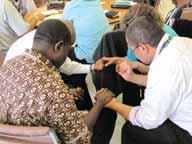



Mennonite Brethren church conference leaders and directors, deans and board members from 30 Mennonite Brethren and Mennonite institutes of higher learning from 15 countries on five continents (representatives from Angola were denied visas) spent a week living in Canadian Mennonite University dormitories, thinking, eating, discussing, laughing and learning together through a daily schedule of singing, devotions, plenary addresses, roundtable discussions, workshops and prayer.
The theme of church and school as partners sparked productive discussions, but also more questions than answers. Sessions were organized around subthemes: Compañeros in biblical and church history, Compañeros in growing people of faith in the Anabaptist-Mennonite tradition, Compañeros in growing people with a vision for mission and Compañeros in growing a people equipped for holistic witness to the world.
ICOMB is a vehicle for partnership between the 18 Mennonite Brethren member conferences in 15 countries. But at this second ICOMB-sponsored education consultation, representatives of Mennonite Church-sponsored schools, Anabaptist institutions and multi-denomination schools with Anabaptist connections fully participated alongside their Mennonite Brethren counterparts. A full report is posted at www.usmb.org/christian-leader.—Karla Braun

Ewert announces retirement
After leading Fresno Pacific University for nine years, D. Merrill Ewert will retire as president, effective July 31, 2012. During Ewert’s tenure, enrollment grew from 2,049 students in fall 2002 to 3,400 in fall 2010, adult education expanded through new regional centers, new academic programs were introduced, the university reorganized structurally, the number of school sports grew and facilities expanded for future growth. FPU is the Mennonite Brethren university headquartered in Fresno, Calif. —FPU

Tabor College RECEIVES FUNDS for theological education
Tabor College, the Mennonite Brethren college located in Hillsboro, Kan., has received $250,000 from the U.S. Conference of MB Churches (USCMBC) for developing graduate theological education and pastoral training. USCMBC Leadership Board Chair Steve Schroeder and Vice Chair Marv Schellenberg made the presentation to the Tabor College Board of Directors at their May 6-7 meeting.
“We are delighted to be at this place, offering support for collaboration with Tabor College to help us as a national family with graduate theological education and pastoral training in partnership with our seminary,” says Ed Boschman, USMB executive director.

Boschman says that from the beginning changing how the national conference provides graduate theological education was a two-step process. The first step was the decision in 2010 to transfer the Fresno, Calif., MB Biblical Seminary (MBBS) operation to Fresno Pacific University, the MB institution in Fresno, Calif.
“Part B was to develop a collaboration with Tabor College for the purpose of graduate theological education and pastoral training nationally and particularly for the Midwest,” says Boschman.
In March 2011 the MBBS Board of Directors disbursed $1.1 million from a distance education fund, including $250,000 to USCMBC. “These funds are the vehicle that is making it possible for us to move forward with the second part of our plan,” says Boschman.—USCMBC
Gifts shared, styles clashed, work done
Relational richness and shared gifts—both figurative and literal—characterized the annual general meeting of the International Community of Mennonite Brethren (ICOMB), held June 17–21 in Winnipeg, Man. Representatives of the 18 member conferences in 15 countries reported on joys and challenges, selected executive officers and heard reports about various ICOMB projects.
But differences in decision making was one of the challenges the group encountered. It was most evident as the group discussed the appointment of a new executive secretary. While David Wiebe, who had been serving as half-time interim executive secretary, was strongly affirmed for the executive secretary position despite his inability to satisfy the criteria of being multilingual and having a Global South perspective, in the end a search committee was formed to review candidates.
ICOMB was formed in 1990 to build partnership for ministry and mission between MB conferences around the world. Ed Boschman represents U.S. Mennonite Brethren and serves as ICOMB treasurer.—Karla Braun
byTheNumbers

4.5 trillion cigarette butts — nearly 2 billion pounds— are thrown on the ground every year. It takes roughly 1,500 butts to equal one pound.


Repurposing cigarette butts is tricky because they are toxic, but researchers are exploring incorporating butts into bricks and a rust control compound.
Source: Miller-McCune
5 minutes with...
Allison Ens
Allison Ens of Community Bible Church in Olathe, Kan., is the Distinguished Young Woman (formerly called Junior Miss) of Kansas. Her extensive resumé includes the Princeton University Fine Arts and Humanities Symposium, Principal Cellist in the Kansas All-State Orchestra and MB Biblical Seminary’s Ministry Quest program. This fall she will be one of three freshman Paragon Scholars at Fresno Pacific University.
What got you interested in the Distinguished Young Woman competition?
I just saw it on a scholarship Web site and thought I might as well try it—and I actually won!
Is beauty a big part of the competition?
Not so much beauty as poise. It’s a category they call self-expression.
What are the other competition categories?
There’s scholastics, talent, private interview and fitness. No swimsuit, thank goodness!
How does it feel to be judged on these things?
It’s kind of stressful, but I do enjoy performing. The talent, where I play my cello, is my favorite part, but the self-expression scares me because I have to talk in front of a huge audience.
How does a Christian approach this kind of competition?
We have to understand that this isn’t entirely up to us. It’s really up to God how this is going to turn out. If you were a non-Christian who didn’t win you might think, “What is wrong with me?”
Of all the honors you have received, which would you consider the most important?
Ministry Quest was a really big thing for me. They taught us about the different varieties of strengths. I learned that I have more an intellectual strength where others might be relational or a worker. That was important for me to learn.
What do high schoolers have to teach adults about being a Christian?
They have a tendency to be very passionate and really go out and do something. Adults sometimes get comfortable with where they are.

Interview by Kathy Heinrichs Wiest
MB Mission to relocate MCC prepares for change
MB Mission, the global mission agency of North American Mennonite Brethren, plans to move its offices and staff to the campus of Northview Community Church, Abbotsford, BC, in the fall of 2012. The mission has been housed on the campus of Columbia Bible College, Abbotsford, for the past 12 years but now has a need for more office and training space. The mission plans to share Northview’s new office and ministry center, which the church is constructing on their site.—MB Mission

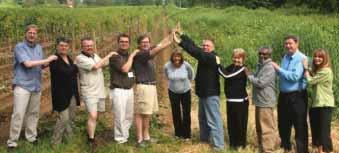
The Mennonite Central Committee (MCC) Annual General Meeting, held June 1011 in Abbotsford, BC, addressed issues related to the implementation of a threeyear restructuring process nearing completion. MCC Binational will be replaced by MCC Canada and MCC U.S. Linking the two bodies will be a joint ministry council comprised of representatives from MCC Canada, MCC U.S. and Mennonite World Conference. Donald Peters, MCC Canada executive director, center left, and J Ron Byler, MCC U.S. executive director, center right, demonstrate the bridging relationship integral to their new partnership. Arli Klassen, MCC Binational executive director, stands between them. They are joined by MCC executive directors, who are standing on both sides of the Canada and U.S. border in Abbotsford and Sumas, Wash. The border, crossing MCC property, is indicated by the cut in the trees. If approval is given by the two national entities, MCC Binational will cease to exist at its final meeting in March 2012, making way for the two new country-based MCCs.—Meetinghouse
U.S. will host next MWC Assembly
Mennonite World Conference, a global fellowship of Anabaptist-related churches, will hold Assembly 16 in Harrisburg, Pa., at the Pennsylvania State Farm Show Complex in 2015. The MWC Executive Committee accepted the invitation of U.S. member and associate member churches at their meetings in May. The committee also accepted the invitation of the three MWC member churches in Indonesia to hold the 17th Assembly in that country in 2021. —MWC
Rios begins MCC assignment
Silvia Rios, of El Faro Community Church, Reedley, Calif., was among 12 workers recently commissioned for new or continuing service with Mennonite Central Committee (MCC), a worldwide relief, development and peace ministry of Anabaptist churches. Rios is a bilingual receptionist with West Coast MCC.—MCC




CPS launches Web site
A new Web site (www.civilianpublicservice.org) chronicling the experiences of participants in Civilian Public Service (CPS), an alternative to the military, during World War II was launched May 15, coinciding with the 70th anniversary of the opening of the first CPS camp. Approximately 12,000 conscientious objectors from 231 religious traditions and more than 400 men with no religious affiliation had taken part in CPS when it ended in 1947. Mennonite Central Committee hosts the Web site. MCC
MCC

Twelve years ago our two families—Geoff and his two girls and Lori and her son and daughter— became one. We married in 1998 while our children were in elementary school, and now all four kids are in college.
Our stepfamily’s journey has been exciting and tumultuous, filled with unexpected pleasures and pain. It is a story shared by many families in our churches. Some, like Geoff, have a blended family because of the death of a spouse, while others, like Lori, start over because of divorce.
Lori’s Story
When I married my high school sweetheart in 1987 I thought I knew everything there was to know about living “happily ever after.” Although my parents and mentors at church saw red flags in our relationship, I felt confident that we could overcome them.
We lived our married life with one foot in the church, the other in the world. When I became pregnant with our son in 1989, I realized I had to make a choice. I chose Christ and began to devote time and attention to reading the Word and seeking peer/mentor groups at my church. Sadly, my husband did not.
Our daughter followed in 1992. As I stayed home with our two young children, my husband struggled with the growing pressure he felt to be a father and to provide financially for our family. It’s a long, heartbreaking story, but suffice it to say that his alcohol abuse escalated to the point of self-destruction. Our divorce was finalized in 1995. He passed away last year at the age of 47.
Although I was devastated by my divorce and felt safe in my relationship with God, I prayed that God would lead me to the right man if God wanted me to remarry. I met Geoff on a blind date and soon felt confident that he was the man I had been praying for.

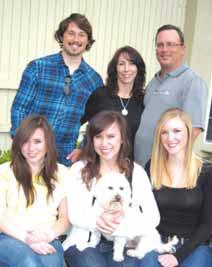

Geoff’s Story
My first wife, Elisabeth, and I married in 1986, and our first daughter was born in 1989. We bought a small home after our second daughter was born in 1992, and Elisabeth stayed home with the girls during their preschool years.
Elisabeth was born with heart deformities; her first heart surgery was as a preschooler. Rheumatic fever in her teens led to Mitral Stenosis in adult life. No one was prepared for the trauma of her death in August 1997 during mitral valve replacement surgery. I became a widower at 35 with two young children.
My new life consisted of work, laundry, dishes, homework and loneliness. The pressure was intense. Ironically, one of the things God used to change my perspective was the movie Titanic. Watching innocent people suffer loss helped me to accept the fact that I was not alone on my journey—other people suffer too. And God began to heal my brokenness.
Soon a neighbor introduced me to Lori. After hearing her story, I felt she would be a great wife and mom. I realized a remarriage with stepchildren would be a challenge, but she was willing to join me in this venture. In October 1998, we had a beautiful outdoor wedding with our four young children participating.
Challenges
When we remarried, we were not ready for what lay ahead. No one is prepared for the new levels of complexity
GEOFF
TAYLOR

by GEOFF AND LORI TAYLOR
that arise in remarriage, many of which come from outside the new marriage. We spent time and energy helping other family members understand that we were all a family now, encouraging them to embrace all four children and not only their biological children. We also spent years in court with Lori’s exhusband, which took a tremendous emotional and financial toll.
We struggled to find others in our church that could help us but realized remarriage ministry was not widely accepted. We felt very alone and isolated from others who did not understand our step-issues.
Although we moved forward confidently in God’s love for our new family, we had much to learn. We were encouraged by the hope found in Colossians 1:17: “In him all things hold together.” We held tight to the knowledge that Jesus was and is with us every step of the way. We reached out to other stepfamilies in our church and started a blended family Sunday school class. Sharing with other people who were in similar situations brought great comfort. We took advantage of the many great books and Web sites available to help us grow in Christ and to grow in our family.
If your new family is a complicated web of relationships, we feel your pain. If your children are hurt and have lost hope, we have been there and grieve with you. Reflecting on our experiences and those of other families, we offer these encouragements.
1. Focus on the marriage. When joining two families with separate cultures, histories and traditions, much energy is spent finding a “new normal.” When custody, ex-relationship and financial issues dominate the home environment, the marriage tends to weaken under this stress. Marriage is not necessarily easier the second time. Marriage is like algebra. Remarriage is like calculus! The children’s security comes from knowing your marriage is stable—even if it’s not what they had hoped for.
2. Recognize and accept loss. Remarriage cannot repair the damage that brought you here. The best response is to offer forgiveness and repentance to all involved. In our case, Geoff even had to forgive God. It is important to model forgiveness and reconciliation to your children. Children carry a lot of pain from whatever circumstances caused them to be in this stepfamily, something they never asked for.
3. Practice the spirit of adoption. Practice adoptive love toward your stepchildren, and free them from false expectations. Rather than trying to replace their natural parent, offer love, support and encouragement as though you adopted them into your life. Be sensitive when discussing their “ other family.”
4. Do not compare your new family to original families. Our family struggled with normal developmental issues as well as step issues. It’s easy to feel like you’re failing your spouse, children or yourself. Find other stepfamilies and encourage each other.
5. Create new traditions. Find compromise through new ideas with birthdays, holidays and vacations. As time goes by, new traditions will build on each other and over the years you will have many great memories. No child or family member will return to the innocent state of your previous life, but you can help them adjust to their new world. Listen to their feelings.
6. Enforce equality and protectiveness. Treat each child in the family with the same standards. Do not divide your family with favoritism. Write down and apply chores, disciplines and rewards equally as appropriate across the board. Your home needs to be protected from other family members who refuse to exercise equality. “Good intentions” will split your marriage along the step line. Everything that comes to the kids from outside relationships should be filtered through your marriage first.
We are a nation of remarried people, and our children are largely being raised in remarried or nonmarried families. While it’s sad that the church is not exempt from this, we Christians have something in our lives that other families are missing: the presence of God and the encouragement of one another.
If we as a people of God come together in prayer and mutual support, God can heal the wounds of our past and bring hope for family restoration. God strengthened and supported us in our remarried journey, and he will do the same for you if you choose to put him first.
Geoff and Lori Taylor have lived in Bakersfield, Calif., for 10 years and attend Heritage Bible Church. They have three children in college and one recent graduate. They share a passion in offering hope to marriages and families, especially stepfamilies.

by WILFRED MARTENS




When Moses conversed with God next to a burning bush in the desert (Exod. 3), God asked him to deliver a message to the Israelites. Moses anticipated a challenge: The people will demand to know the name of the one who sends the message. “They will ask me, ‘What is his name?’”
God gave a strange response to Moses, words that may have initially confused him. God declared his name: I AM WHO I AM. This answer seems an odd way for God to respond as a means of identification. In reference to the grammar, “I” is the subject and “am” is the predicate verb, a sentence with a simple syntax but a profound meaning.
In a novel that was popular a few years ago, The Shack by William P. Young, an Asian woman named Sarayu, who is a manifestation of the Holy Spirit, says to Mack, “I will take a verb over a noun anytime…. I am a verb, I am that I am. I will be who I will be. I am a verb! I am alive, dynamic, ever active and moving. I am a being verb.”
The expression, “I am a verb,” is also used by philosopher R. Buckminster Fuller in one of his poems: Here is God’s purpose for God to me, it seems, is a verb not a noun . . . Yes, God is a verb, the most active, connoting the vast harmonic reordering of the universe from unleashed chaos of energy.
A grammatical analysis can often unlock meaning from a sentence. What does it mean to describe God as a verb, and what is the meaning of God’s response to Moses, I AM? Why did God choose this unusual and ambiguous expression as a means of identification?
Obviously, the conversation between God and Moses was not in English. The I AM is a translation of the ancient texts. Though English grammar is quite different from Hebrew and the ancient texts, it is amazing—a miracle—that God’s word transcends and survives translations, so that an analysis of a translation can still draw the reader to the meaning of the text.
The traditional English grammar system with its many prescriptive rules was inherited from the ancient Greeks. Aristotle suggested that a sentence has two parts, a subject followed by a predicate. The subject is ordinarily a noun or pronoun, and the predicate includes a verb. Scholars declared that the verb is the most noble part of the sentence; it is the core, for without a verb, a group of words is only a fragment instead of a complete sentence. Even if a sentence contains only one word, that word must be a verb (for example, Run! Wait!).
God’s sentence of response, I AM, begins with a first-person singular pronoun. Throughout the conversation with Moses, and the entire
God’s sentence of response, I AM, begins with a first-person singular pronoun. Throughout the conversation with Moses, and the entire Pentateuch, God uses the same subject: I have, I am, I will, I know, and so forth. It was a reminder to the Israelites who were intrigued by the numerous gods of other cultures and nations that there is only one true God. Moses understands the meaning of the singular subject when he declares, “Hear, O Israel: The Lord our God, the Lord is one” (Deut. 6:4, RSV).
By using the word “AM” God is using a form of the verb “to be.” In English this verb is unique; it is different from other verbs. Others have the typical three or four forms (for example, walk(s), walked, walking). But “to be” has eight: is, am, are, was, were, be, been, being. To recognize “AM” as different from all other verbs is to acknowledge God as a distinctive and unique being. In this spirit, Moses reminds Pharaoh “that you may know that there is no one like the Lord our God” (Exod. 8:10, NASB). A number of times he reminds the Israelites “that the Lord is God in heaven above and on the earth beneath; there is no other” (Deut. 4:39, RSV).
Another characteristic of the verb “AM” is its “present-ness.” By using the present tense God emphasizes timelessness. We humans are bound by time, and it is impossible for us to fully comprehend a God who is timeless. Because we are unable to break out of our concept of
time, we often refer to God with language of past-present-future.
But C.S. Lewis cautions us about this practice. In Letters to Malcolm he comments on our prayer habits: “Our prayers are heard—don’t say ‘have been heard’ or you are putting God into time— not only before we make them but before we are made ourselves.” The Psalmist also notes this “present-ness”: “God is our refuge and strength, a very present help in trouble” (Ps. 46:1, RSV). And God reminds Malachi, “For I the Lord do not change” (Mal. 3:6, RSV).
We live in an age that relegates God to the past tense and in which Christians and the church are tempted by multiple “ism” gods—nationalism, materialism, hedonism, militarism and so forth. God’s revelation as “I AM” is a reminder that God is one, and that God exists and is omnipresent. The two-word name, so simple and compact, yet so profound and full of meaning, has significance for a world characterized by violence, poverty, greed and suffering. As Sarayu says to Mack, “Unless ‘I am,’ there are no verbs, and verbs are what makes the universe alive…. My words are alive and dynamic—full of life and possibility.”
Wilfred Martens is professor emeritus of English at Fresno Pacific University where he retired in 2000 after 35 years of teaching. He and his wife, Erma, are active members of College Community Church MB in Clovis, Calif.



For God to me, it seems, is a verb, not a noun...Yes, God is a verb, the most active, connotating the vast harmonic reordering of the universe from unleashed chaos of energy.





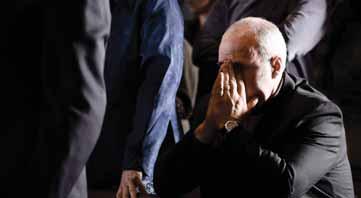
There is no easy way to navigate grief. In our heads we know death is a natural part of life. But when loss and grief invade our lives it seems anything but natural. Our life comes to an awkward standstill while everyone and everything else just keeps moving on.
We grieve as individuals, but we rarely grieve alone. Death is part of being and doing church together. How can the church come together to be a helpful and healing place for individuals, families and the whole congregation to experience and navigate the journey through loss and grief?
As one church family, here are some of the things we have experienced, some of the things we are learning and how we are growing and changing through experiencing God in the midst of difficult times.
Phase 1: Preparing for loss and grief
Playing together
One of the best ways to walk through grief is to have a depth of relationship before death or loss comes your way. A congregation that spends time together, likes being together and worships, fellowships and eats and plays together is setting itself up well to successfully grieve.
Living ready
Some loved ones die suddenly and without any advanced warning, but many are given a diagnosis and wrestle with illness for weeks, months or even years. Anticipatory grief or pre-grieving often happens during this time.
Support for the ill and the family is important. Prayers, cards, conversations and practical help are all welcome. I know some friends who came over and planted favorite flowers for one woman who was in the last weeks of hospice care in her home.
A couple of years ago members of our church responded to what seemed like a growing number of people diagnosed with chronic or terminal illness by forming Assurance, a support group for 14
individuals with these illnesses, family members and also survivors. It has been a vibrant and life-giving place within our faith community. It has been a place of witness and outreach as some from the surrounding community have joined. However, the reality of the fragile nature of the group is always present. One of the founding members has already passed, and the group has said farewell to others too.
Creating a culture where the church body cares for itself rather than leaving it to the pastor or trained caregiver is a helpful aspect of being the church. This should be a natural outflow of being Christian, but structuring the ministry can also be helpful.
Members of our church have developed a Congregational Care Team that prays regularly for all those who are ill, follows up on those who cannot attend services, goes to hospitals to pray with people before and after surgery and visits those in care homes. Some churches have deacons who fulfill this ministry. A blend of organic and structured caregiving is helpful, and even then I still find some people’s needs going unnoticed. It takes an attentive and responsive congregation to really be in tune with each other’s needs and follow up accordingly. Our congregation has been hit hard recently with unexpected deaths, a number of them at age 50 and under. This has been a wake-up call for many to take care of end-of-life issues. Practical things like life insurance and a will or living trust. Physical things too—many that haven’t been to the doctor in years have gone in for a checkup. There are relational and spiritual implications as well—am I in right relationship with God and with others? Am I living with any regrets? Is there anything I can do to restore relationships?
Do your ‘theologizing’ beforehand
Having much of your theology on death and dying in place before you are personally surrounded by it is very helpful. Scripture has much to say on the topic. God’s Word is very meaningful in the midst of grief. 1 Thessalonians 4 tells us that as followers of Jesus we are people who grieve, but not as those who do not have hope. The reality of that verse is very true and helpful as a community experiences and encounters grief.
However, we may not always feel hopeful in the midst of our grief. The last thing we need is someone telling us we should. Expecting those who are grieving to feel or think a certain way is not realistic or fair. Maybe it is at that point where the body exercises her role in doing the hoping, believing, praying and trusting on behalf of those who presently cannot.
Phase 2: When death strikes
The “week from hell”
Most death to burial timelines happen in about one week, give or take. That week is one of the worst someone can experience. It is not necessarily that the grief is more intense— though it could be for some—but that a person is in shock, emotions are raw, 100 decisions need to be made, sleep is little, people are everywhere, family dynamics are magnified, they
are overwhelmed and often it seems like there is virtually no time or space to grieve because of everything else going on. Practical help is especially meaningful during this week. Make a meal for the family. Bring goodies and finger foods for the many people who may be visiting. Help with childcare issues. Wash a load of shirts or blouses and do the ironing. Loan a car to be used by family from out of town. Money might be an issue. Contributing to the funeral expenses may be a huge blessing. It is helpful if some of these details (like meals and finances) are organized through the church. People need to be encouraged to help however they feel led. Generally, authentic expressions of compassion do more good than harm.
Cards and other remembrances acknowledging the loss are also meaningful. They allow others to connect in some way and for the family to know they are being thought of and prayed for. The power of a praying church is especially important during this time and possibly the single most important tool we have to help during grief.
A pastor or skilled caregiver being present at the funeral home and helping make decisions about the memorial service and other relevant end-of-life decisions is also often helpful. While living, some people write down some of their thoughts of what they would want in their service. This is very helpful for the family and the officiating pastor. The memorial service really is for those who are living, but usually the family feels best if they know they are honoring the desires and character of the one who has passed.
The ministry of presence
It is hard to know how to respond and what to say to someone who has just lost a loved one. Many who gave feedback about their personal experience say they have been wounded by the words of others during this time. Interestingly, it has been pastors, “experts” and conference leaders who topped the list as least helpful in a verbal sense. I think that is because we feel we have to say something profound or helpful at that moment.
Often being present is the most significant ministry, more than the words you speak. Be present, offer condolences, give a hug, pray. Attend the memorial service. If appropriate, visit their home and only for a brief time. While potentially awkward, acknowledging the loss is important. However, offering commentary, answers or glib remarks about hope or afterlife ring hollow and can sting. Avoid the temptation of using your words to make things better. Your presence and your shared grief are best at this point of the process.
The gift of story
One of the best gifts a family and a congregation can share during this time is that of story. Telling stories creates a shared experience. Many family members are extremely touched by hearing how their loved one impacted the life of someone else. Sometimes the memorial service or reception offer open mic


We grieve as individuals, but we rarely grieve alone. Death is part of being and doing church together.


times where these stories can be shared verbally. Regardless, writing the story down and sharing it with the family is extremely valuable.
Sharing your grief, without dumping it on them, can also be helpful. One of our members who recently lost his spouse said, “I received the blessing that my grief and loss of my wife was also being experienced by NFC. That shared grief has been great comfort to me.” However, don’t show concern for someone else and then use the conversation to process your own grief.
Phase 3: Moving beyond loss and grief
Give time
There may be some wrong ways to grieve (e.g. selfmedicating to relieve the pain) but there is no one right way. Individuals are different. Give people space to walk through their grief. Putting a timeline on someone else’s grief is not helpful or right. And just because you have experienced loss yourself does not mean someone else will experience it in the same way.
Minister out of your experience but don’t project it on them. Avoid judging another family if they lost their child five years ago and are still struggling in the grief process. Poll five people and you will probably get five different opinions on the right amount of time before someone can remarry. A helpful and healing community is one that offers each other time and space to move through the many aspects of grief with much grace and by being present to support. There are usually many good and bad days over the months and maybe even years after the loss occurs.
Give space, but stay connected
Staying connected without smothering the individual or family is important. Often coming back to worship services is extremely difficult. The music and environ-
ment are often very raw and evoke much emotion. People also feel very conspicuous because of the recent public awareness of the events in their family. They may wish to be more “anonymous” at first—coming in late and leaving early.
This is also a critical time for some, especially those on the margins of the congregation. If too much time goes by without connection with the church they can easily fall away from the faith community. Be on the lookout for these individuals while being careful of the weekly “Where were you last Sunday?” phone calls. Some find continuing to serve in a place of ministry a very positive aspect of walking through their grief. Contributing to and investing in someone else can be a very good outlet and therapy for grief. Grief support groups, offered through the church or local hospice organization, can also be very valuable.
The person is more than their loss
The loss is a significant part of the person’s experience but is not all there is to that person. Knowing the other aspects of someone’s life and relating to them on personal, professional and relational aspects is welcome. The ongoing “How are you doing?” question is not helpful. It continues to focus on that one aspect of the person’s life and is difficult if not impossible to answer. Don’t pretend the loss didn’t happen, but also don’t let it become the only focus of attention and interest in that person’s life.
There is much to learn in this whole area of walking through grief together. A depth of relationship before crisis hits, practical support during the crisis and longterm support afterward are all helpful. We are learning from our “successes” and “failures” in this area. Sometimes we learn that no one called, made meals or followed up. That hurts.
Ask people in your congregation: “What has the church done that has been helpful in your grief process? What hasn’t been helpful?” Their answers can make for a very eye-opening and empowering conversation. Hopefully they will have some encouraging things to say about how they have experienced God through their church community. And hopefully we can learn from our failures in becoming a more helpful and healing community.
James Bergen is the lead pastor at North Fresno MB Church, Fresno, Calif. The congregation provided much feedback in forming this article.
Here comes El Faro!
The neighborhood teenagers were just plain disruptive. During services of El Faro Community Church, a small, Hispanic Mennonite Brethren congregation in Reedley, Calif., the boys would scream, curse, throw rocks and slam doors to get attention. They had grown up in the neighborhood and knew those attending the church, but showed no respect.
The El Faro congregation wanted to reach out to these teens, but didn’t know how. So they simply asked the boys: Was there some positive activity they would rather pour their energies into?
The response? They wanted to play soccer.
Immediately, a deal was struck: If the boys would gather enough players for a team, the church would sponsor them in a league.
That was in June 2010. Just over a year later, the El Faro congregation can worship in peace. But the transformation
has been much more far-reaching. “There has been a huge change in the players’ character, in their relationship with the members of the church and even in the neighborhood,” says Silvia Rios of the El Faro congregation.
El Faro members Ignacio Cuevas and Max Rios, Silvia’s father, coach and manage the team of about 20 players ages 14-17, including one girl. Committing to coaching a soccer team was no small thing for them, since neither was familiar with the game. In fact, they didn’t even particularly like soccer. But that’s what the teens asked for, so Cuevas and Rios learned—from the players, from other coaches, even from referees at games. Now Cuevas finds himself eagerly watching professional soccer on television.
At first, the team lost consistently and badly; a 14-0 thrashing was not unheard-of. But something happened as the team continued to practice and improve, as coach-
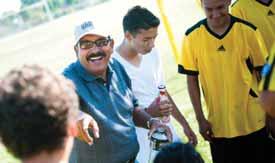


PHOTOS BY ANDREW SHINN
es continued to model sportsmanship and character. “Teams started to recognize that this is a tough group; they really are determined to win,” Silvia says. Instead of thinking of the team as “that little group from the church,” opponents began to say, “Here comes El Faro.”
The El Faro team participates in various leagues throughout the area so that they are always practicing and playing soccer. The team practices several times each week and usually plays twice a week. It’s quite a time commitment for both players and coaches. “I can tell you,” Cuevas says, “having a team is like having an extra family!” But the time commitment is part of what’s been positive for the teens. Simply put, they’re too busy and too worn out to get into much trouble.
Even better, each moment spent together becomes an opportunity for coaches and volunteers to build relationships, share about Christ and model Christian values. Coaches pray with the team before each game, but it’s often the inbetween moments that become most influential. Silvia says, “It’s while they’re out on the field, it’s while they’re being driven to the games, it’s while they’re practicing that they’re being talked to about the Lord, and they are making (good) decisions.” Several players have improved their grades at school and eight have made firsttime commitments to Christ.
The El Faro congregation has embraced the soccer team as their own. Volunteers help with transportation, raise funds to buy equipment and uniforms, bring snacks and food to games and, most importantly, pray for and build relation-
ships with the teens. Before the team formed, interactions between El Faro members and neighborhood teens were often filled with animosity, swearing and disrespect. Now interactions are more likely to include a friendly greeting, a hug and a prayer. “They have become part of the El Faro family,” Silvia says. In June, the congregation planned a dinner to celebrate the one-year anniversary of the soccer team.
The transformation in this neighborhood has been dramatic enough to catch the attention of the local police. The coaches were recently invited to a meeting at a local elementary school in which the chief of police
publicly recognized a change in the community, thanked them for their work and encouraged them to keep making a positive difference in their neighborhood. Cuevas remembers, “He said, ‘You guys have done more in one year than we can do in years.’”
Cuevas hopes the changes they’ve seen are only the start for these teens—that they’ll be encouraged to finish school, get an education, dream about a better future. In an environment filled with the influence of drugs, violence and gangs, that couldn’t be more critical. “We want something better for them,” Cuevas says.—Myra Holmes
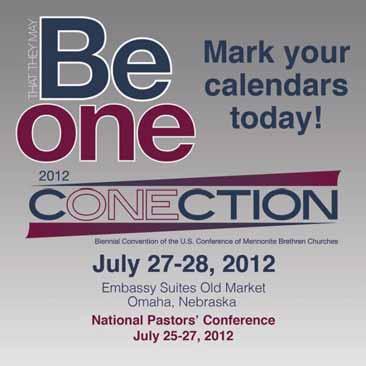
Pastor sees hearts changing in Japan
Located just four miles from the nuclear power plant in Fukujima, Japan, First Fukushima Baptist Bible Church felt the full force of the three disasters March 11. The earthquake rocked the church itself, scores of church members were lost in the tsunami and the radiation leak from the power plant forced the evacuation of many who remained.
Prior to March 11, Chieko Satou dreamt that she and her husband, Akira Satou who is the pastor of the Fukushima congregation, traveled across the country with their congregation. When 60 members of the congregation (mostly seniors) were forced to find refuge more than 200 miles away at the Christian Bible Center, they recognized that Chieko’s dream was God’s message of reassurance, preparing the way and strengthening their faith.
Hajimu Fujii, pastor to two Japanese Mennonite Brethren churches in California and a close friend of Pastor and Mrs. Satou, sees this church’s experience as one of many ways that God has been moving in and through the disaster to speak to the people of Japan.
“My impression is that after the disaster people’s hearts are changing,” says Fujii, who visited Japan with his wife, Kayoko Fujii, just three days after the quake on a trip planned well before the disaster. He tells of one middle-aged man who heard Fujii preach. In his sermon, Fujii encouraged his listeners to boldly share their faith and to take this opportunity when people are looking for answers. More than a week later, the man drove two hours to tell him about the change in his life. Though Fujii had already returned to the U.S., the man talked with Kayoko.
Two friends from Fujii’s Hiroshima high school days also called on him during his stay in Tokyo. To his surprise, “they were open to hearing about the Lord.” Fujii says, “The time has come. People are opening their hearts.”
On his return to the U.S., Fujii mobilized his Mennonite Brethren congregations to assist the Fukujima congregation and to support other Christian relief efforts. Members of North Fresno Japanese Chapel and Sacramento Bible Church as well as the monthly Bible study group Fujii leads in San Jose all pitched in to give and raise funds in their communities.
They collected donations at local universities, a Japanese school and Japanese gardens. They sold oranges and baked goods and planned a benefit piano concert. To date, they have raised $12,500.
Even while raising funds for disaster relief, Fujii remains committed to his primary goal of spreading the gospel to the Japanese people. Just as he sees a new openness in Japan, he also notes that even before the earthquake, Japanese living outside their home country tended to be more open to Christianity. “In one year about the same number (of Japanese people) are saved outside Japan as in Japan,” says Fujii.
The challenge he brought in his messages to the Japanese churches is the same message he drives home to his California congregations. “Our church is small, but we have big responsibility,” he says. “It’s a good strategy for Japan’s evangelism to preach the gospel to Japanese while they are outside Japan.”—
Kathy Heinrichs Wiest
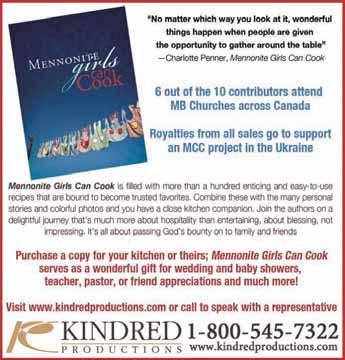
César García: From “second conversion” to MWC helm
This month César García, a Mennonite Brethren pastor and conference leader from Bogotá, Colombia, begins serving as general secretary-elect of Mennonite World Conference, a global community of Christian churches rooted in the Anabaptist movement. After a transitional period starting in August with current secretary Larry Miller, García will begin his term as general secretary Jan. 1, 2012.
As one amateur Mennonite historian likes to point out, the only real Mennonite name is Menno Simons. From there on down through history, the rest of the family names are just “add-ons.” After a series of Mennonite World Conference (MWC) secretaries named Dyck (1961-73), Kraybill (1973-90) and Miller (1990-2011) the name of García stands out as an historically recent addition to the Anabaptist family.
César García’s personal story with the Mennonite family began in Bogotá, Colombia, when his mother took him and his sister to several churches in search of a new church home. Eleven-year-old César chose Iglesia Hermanos Menonitas Dios es Amor (God is Love MB Church) as the place they would settle.
That choice was the first step on a continuing journey for García, who has come to treasure Anabaptist theology and history and has given his life to scholarship, to mission and to shaping the church from an Anabaptist perspective.
A drive to understand Scripture and have a reasoned faith has characterized García’s walk since what he calls his “first conversion” at age 19. After rejecting God and the church as a teen, García found himself depressed and unfulfilled by the existentialism and other philosophies he was pursuing. “The sense of vacuum was huge,” he says.
Under pressure from his mother to come back to church, García attended a
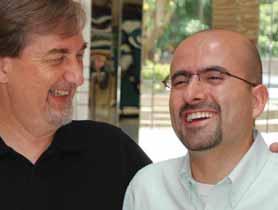
Dios es Amor youth meeting where he was touched by the speaker’s assertion: “God doesn’t see us as a problem but as a possibility in his hands.” Half-believing that he was just “talking to the walls,” García told God that he wanted to experience that hope.
“The next day my life was different,” he says. “I decided to read the Bible, come back to church and start looking for responses to my atheistic arguments.” Not satisfied with a personal emotional experience, he also began a lifelong pursuit of theological study, mission and church ministry.
García worked for six years at a Christian radio station where he interacted with Christian leaders from charismatic, evangelical and mainline denominations. “It was a time of growing theologically,” he says of those years teaching and counseling in his radio ministry and serving as youth pastor and elder at Dios es Amor church.
More formal education at Seminario Bíblico de Colombia, an interdenominational seminary in Medellín, earned him a Bachelor of Theology and Bible with an emphasis on missiology and gave him the tools for studying Scripture. Well versed in Protestant theology, García was now ready for his “second conversion”—to Anabaptism.
Juan Martínez, then president of the SEMILLA Latin American Anabaptist Seminary in Guatemala, challenged García to complete his education by studying Anabaptism. When García and his wife, Sandra Báez, moved back to Bogotá for church ministry he took up the challenge, starting with John Driver’s book, Eclesiología Radical. “It was amazing,” García says, “like candy for a child.”
When current MWC general secretary Larry Miller (left) completes his term Jan. 1, 2012, César García (right) will begin serving the global Anabaptist community.
MWC
A year later, he and Sandra were commissioned as MB church planters in Bogotá and seized the opportunity to weave their newfound theology into every aspect of Iglesia Hermanos Menonitas Torre Fuerte (Strong Tower MB Church). “I was excited about participative community, restorative discipline, servant leadership, communal hermeneutic. It was so clear that I wanted those kind of values for our new church,” says García. The spirit of community drew new believers, and the church grew and flourished.
As much as he values the ideas and principles of Anabaptism, García also cherishes his relationships in the global Anabaptist community. Fellow leaders in Portugal and Venezuela are now counted among his closest friends because of their work together in the International Community of Mennonite Brethren (ICOMB).
Other new friendships have developed among Mennonite Brethren, Brethren in Christ and Mennonite Church leaders in Colombia. After some periods of little interaction or cooperation between the
three denominations, “Mennonite Central Committee helped us to realize that in reality we were not so different and that many of the suspicions between us were only that,” says García.
“There are differences, but that doesn’t mean we have to fragment,” he says. “The body of Christ is a living organism that demands diversity, but also requires love and unity.”
One of the bridges García is determined to strengthen is the one between people with a long Mennonite pedigree and those who have come to Anabaptist faith more recently. At the same time, he knows from experience the value of coming to Anabaptist faith by conviction rather than heritage.
“It gives the opportunity to have a passion—to fall in love with the tradition,” says García. “We need to value Anabaptism by conviction, but we also need to maintain our historical tradition and to learn that those things are related and not opposed,” he says. “We are thirsty for identity. In Anabaptism we find a body that offers that—not just theologically, but also historically.”
César García is quick to point out that his appointment as Mennonite World Conference (MWC) general secretary is just a continuation of a long history of Mennonite Brethren activity in MWC. Pulling his copy of A History of the Mennonite Brethren Church by J. A. Toews off the shelf, García opens right up to some well-used pages highlighting 1930 as the first time Mennonite Brethren participated in MWC, a host of MB participants in the 1948 Assembly held in Indiana and the MB General Conference’s official approval of MWC membership in 1951.
García counts himself as following in the line of Mennonite Brethren leaders C.F. Klassen and P.C. Hiebert who held MWC leadership positions in the early years. He also points to current MB leaders Paraguayan
Few who know García would consider his new appointment surprising. Recognizing his unique gifts of learning and leadership, many have invested in his education and preparation for ministry. Perhaps least surprised of all is García’s mother, Evelia. She was 45 years old when she became pregnant with this son. The doctor advised her that, because of her age, the child was at risk. She pleaded with God for a healthy child and, like the biblical story of Hannah and Samuel, consecrated her son to God for ministry.
With a wry smile García remembers how aggravating it was to hear his mother recount that story during those rebellious teen years. But today he finds it reassuring—a reminder that God’s gifts and blessing are on him from before his birth. And with this call to ministry comes God’s spirit to guide and give strength for the task ahead.—From an article by Kathy Heinrichs Wiest for MWC and Meetinghouse, an association of North American Mennonite and Brethren in Christ publications. Visit CL Online (www.usmb.org/christian-leader) for the full story.
Alfred Neufeld, president of MWC Faith and Life Commission, and John Fumana of Congo, who is part of a Global Anabaptist Service Consultation task force.
According to García, the value of MWC comes in the diverse points of view it brings together, with each participating church body bringing something of value from its own tradition. Mennonite Brethren, he says, contribute a strong pietistic emphasis on prayer and worship and a commitment to evangelism. Other traditions bring in other emphases such as the Holy Spirit or discipleship or peacemaking.
“It’s a mixture that I like,” says García. “If we want to evangelize we have to be peacemakers; if we want to be peacemakers we have to rely on the Holy Spirit.”—KHW
Exercising their faith
Sometimes God gives his people gifts that are a bit unusual.
“We kind of question, ‘Lord, what should we do with this?’” says Winnie Bartel, advisor to the women’s ministry team at Shafter (Calif.) MB Church.
About a year ago, the women’s ministry team at Shafter MB received a donation of exercise equipment from a national-brand women’s fitness center that had gone out of business. “It was too good to pass up,” says Bartel. The team immediately began brainstorming how to use the unusual gift to reach out to both church and community.
Exercise is nothing new at Shafter MB; an aerobics class has been meeting there regularly for about eight years. But the gift of this equipment presented an opportunity to take the church’s ministry through exercise to a whole new level.
After consulting with church leaders, the women installed the equipment in an area of the church building with an exterior entrance. The former fitness center owner trained the team on how to properly use the equipment. And the Exercise Club was born.
The Exercise Club already has about 50 members. About a third of those are from outside the church family; a handful are men. For a $25 annual fee, Exercise Club members can use the equipment between 6 a.m. and 9 p.m., any day except Sunday.
While an exercise room in a church might be unusual, the Shafter women believe it’s a fitting combination. “Wholeness is mental, physical and spiritual,” Bartel says.
“If you’re a student of the Word, you don’t have to look too far to see how the Bible ties the spiritual and physical together.”
That connection is being played out in the exercise room as Club members pursue physical health and find relational and spiritual benefits as well. One group of senior women bond over their regular morning workout. Working women bring coworkers for a 30-minute routine in the evenings, building friendships as they do. A bulletin board in the room that advertises church activities and women’s events has also provided a way for Exercise Club members to care for one another as they post prayer requests.
It’s a nice start, but the Shafter women’s ministry team hopes this equipment will be the catalyst for much more. “We are limited only by our imagination,” Bartel says.
So this month the Shafter women will launch “phase two” of their exercise ministry with a half-day health seminar designed to encourage both physical and spiritual health. The Aug. 14 event will feature tips on exercise and healthy eating as well as testimonies to demonstrate how a relationship with God is a critical part of whole health.
The church’s exercise room is now the only fitness facility in a community that is keenly interested in health. In June, the city sponsored a health fair, and Shafter MB was encouraged to advertise their Exercise Club and upcoming health seminar. “Shafter is becoming a very healthy community, and our church is at the forefront,” Bartel says.—Myra Holmes


Let’s grow together

Welcome to the new Everence – the result of MMA and Mennonite Financial Federal Credit Union growing together to offer you complete financial services rooted in faith and values. Talk to your local representative or visit www.everence.com to learn about the new benefits of becoming a member. A ministry of Mennonite Church USA and other churches elcome Ever W















Don Morris Mission USA director
Thriving in red clay soil
I’m sitting in my home office looking out at our front yard where a tree grows. Why is this of any significance? It has taken my wife and me seven years to grow a tree in our front yard.
You see, we live in Oklahoma, and the soil in this part of the state is made up of red clay that creates an unbelievable barrier to tree roots. When a person digs with a shovel and chips with a pick and then digs and chips some more into this red stuff, sweating and moaning, just to make a hole in the ground to plant a tree, that hole quickly becomes just a big clay pot in the ground. Tree roots hit the end of the dug out hole and stop cold. The roots then wrap around and around, never going deeper than the hole, and the soil in the hole easily dries out. The tree struggles to survive in this pit—and well, it’s not a pretty picture.
We have previously planted four other trees that I can count in the dreadful tree hole in our front yard. They all succumbed to the “clay pot beast”— dead within weeks.
But finally we have a tree that is growing. We just had to find the kind of tree that is able to beat the clay pot. Actually, we finally got the brilliant idea of asking a nursery expert what kind of tree to plant. This tree, a Bald Cypress, is now growing like it doesn’t know what a barrier is. It loves red clay.
Now the analogy: In my opinion church plant-


ing is a lot like growing trees in challenging soil conditions. If we don’t insert the right kind of church plant into what are oftentimes very difficult circumstances and demographics, these church plants will likely succumb just like our first four trees did— dead within just a short period of time.
But with the right plan, the right planters and the right supporting team, we can watch these new churches grow—like they don’t know what barriers are. Obviously, we must ask the expert Gardener what and how to plant.
As one of those entrusted with church planting among Mennonite Brethren in the United States, I know how crucial it is that we get this right. As I watch the tree in my front yard, the green leaves are dancing brightly in the breeze. And even though it won’t last forever our tree will likely last for a long time.
But with church planting, the results do last forever. A thriving church plant reaches people for Jesus. A thriving church plant helps people follow Jesus, growing and maturing in their walk. A thriving church plant helps us as a conference of churches to be active, supportive and more alive as well.
Even in the difficult areas and in these challenging times, we’ve got to get church planting right. If we do, we’ll watch these new churches grow, thrive and dance in the breeze.



Only 15% of Millennials (those born between 1980 and 2000) are Christians.

Source: The Christian Post
Discerning Littleton’s greatest need
The Micah Project (TMP), a church based on Micah 6:8 and planted Jan. 1 in Littleton, Colo., wants to grow deep connections with the community. “We are seeking one specific mission that we can embrace and throw our energy into,” says church planter Vaughn Jost. “The question we’re asking is: What’s a great need in Littleton that we can match to TMP’s giftedness?” In an attempt to discern Littleton’s needs, Jost continues to meet with various leaders in the community, including city officials and school administrators.
Four key core team couples have joined Jost and his wife, Taryn, in this new venture born out of Trailhead Church in nearby Centennial. Trailhead, under lead planter Jeff Nikkel, began in 2006 and has already multiplied its influence in the Denver area through TMP.
Three of TMP’s core team couples have strong ties to Trailhead. “It was tough to leave Trailhead,” says Dave Cartwright, “and we prayed long and hard before we decided to commit to being a part of TMP. But my wife and I have made the commitment to give up what we’re receiving for ourselves at Trailhead to be on mission with TMP. We want to help make a difference in the lives of people in Littleton, and we love working with Vaughn and Taryn.”
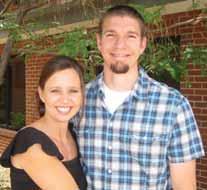
A fresh look at church health

Under the umbrella of Mission USA, the U.S. Conference of MB Churches is providing oversight for a revamped national church health program that will focus on providing various tools for pastors and church leaders. Mission USA is collaborating with district leaders to develop this ministry. The program will include church health survey consultations, regional leadership seminars, conflict resolution assistance and other leadership enhancing resources.
But perhaps the most important piece of this new program is providing coaches for pastors and church leaders. According to many people involved in promoting church health, solid coaching is a key element, as it provides leaders with deep accountability and insight, maximizing a leader’s potential and ultimately the potential of the church. Coaching keeps vision on track. It keeps leaders focused on the right things both in ministry and in life.
The current plan is to train six or seven Mennonite Brethren leaders over the next year through the coach-training program of Ministry Coaching International. These trained coaches will then be certified to train additional Mennonite Brethren leaders as coaches, ultimately providing a strong network of certified coaches.
“Our goal is to have trained coaches that are available for any MB pastor or key leader who desires to have one as the network of coaches develops,” says Don Morris, Mission USA director. “It will take a little while to build up that coaching team, but we want to do it right and to make sure our coaches know how to coach well.”
VAUGHN JOST
Melodie Davis

Whatever happened to dinner?
With overscheduled kids involved in extracurricular activities three to five evenings a week, parents working a three to 11 shift or until 7:00 or 8:00 p.m., who has time for a 50s-style family dinner with Dad carving roast beef? It isn’t going to happen.
And yet children, families, churches and the whole community—even the larger society—benefit from frequent family dinners. The Center on Addiction and Substance Abuse of Columbia University, N.Y., has frequently studied the importance of meals as a nurturing environment for children. A 2009 study found that compared to teens who have frequent family dinners (five or more times per week), those who have infrequent family dinners (fewer than three per week) are twice as likely to use tobacco or marijuana and twice as likely to expect to try drugs in the future. Other studies show that kids living in homes with frequent shared mealtimes get better grades.
What are children getting when they sit down to a meal, besides the meat and potatoes—or salad and stirfry? On a good day, children get attention that leads to parents and kids who are more involved with each other’s lives. Children learn to have conversation. They may get

laughter and precious family bonding time. Usually they get better nutrition.
Dinner may also be the only time the family gathers to pray. Somehow that simple daily act—especially if you’ve been arguing or grouchy right before—forces families to change gears and perhaps find peace amid squabbles.
How can you make it work? Whether Mom, Dad or the kids cook, here’s a half dozen starter tips: Start with something manageable. Can’t manage dinner six or seven nights a week? Aim for three or four— and don’t think you’ve failed if that doesn’t always work.
Be flexible in timing and menu. Moms I’ve talked to since writing Whatever Happened to Dinner say they aim for anytime between 4:30 and 7:30 p.m. according to what is going on that day for each family member. Regarding menu, sometimes an evening meal can be pancakes or even cereal.
If you have to eat on the run, pack a quick picnic sometimes rather than buying fast food. Eat at Mom or Dad’s office or in a park close to the ball fields.
Planning is half the job. Virginia found that involving her children in meal planning, allowing them to each have a meal when they can choose what’s for supper, helps keep her organized. The kids, ages seven and 10, love having a say.
Make it fun. Steve and Leann have “Supper Surprise Night” when they draw slips of paper from a box with various ideas for “mixing it up”—eating on a blanket on the family room floor, eating without utensils, having dessert first, playing restaurant, etc.
Focus on the conversational menu, too. Don’t bring up bad grades, finances or other mood wreckers. Let each family member tell the best thing about the day.
One Sunday morning the youth at our church were leading worship focusing on the fruits of the Spirit: love, joy, peace, patience, kindness, etc. (Gal. 5:22). In one skit, the youth gave one-line definitions of love. Andrew said, “Love is my mom making dinner.” I can’t think of a better way to summarize what family meals can mean.
Melodie Davis has written the syndicated newspaper column “Another Way” since 1987 and is the author of 11 books on family living, including Whatever Happened to Dinner? Recipes and Reflections for Family Mealtime, published in 2010 by Herald Press. Davis lives in Harrisonburg, Va., with her husband; the couple has three adult daughters.

Justin Salters
To the uttermost parts of the Web
Ihave grown up logged into AIM, MySpace, Facebook, Twitter, LinkedIn, Blogger, FourSquare and just about any other social network you can imagine. Maybe that’s why it seems natural and acceptable to share my thoughts, opinions and reflections to the world via the Internet. It also may explain why I believe social media empowers us as believers to do great things for the sake of God’s kingdom.
When the apostles and leaders of the early church communicated the gospel they wrote and sent letters via the roads, cities and ports built by the pagan Romans. Today we have more than roads and ports. Planes, trains and automobiles have taken us places we never thought possible and have mobilized the church. Social media is the next great technology that will allow for the quick and authentic spread of the gospel. Social media allows us to go places we never thought possible and to be salt and light to the world, all from the convenience of our iPhones.
I have recently become involved with People of the Second Chance (POTSC), a grassroots movement committed to radical grace in life and leadership. One of the ways I am involved with POTSC is through Grace Mob, a group of people committed to using our respective social media platforms expressly to advance the causes of grace and love.
Daily I hear stories of people for whom life has proven difficult—people struggling with disease, depression, loss of life and even with self-harm. Most of the people I interact with live hundreds, if not thousands, of miles
from my home in Southern California. They go to churches I’ve never heard of, work at places I will never visit and for all intents and purposes live an anonymous life—except that they use social media to communicate their reality and share their hurt. Then I and the rest of our Grace Mob step in and flood Facebook walls, e-mail inboxes and Twitter feeds with messages of encouragement and affirmation. It is amazing what a message of God’s love and sovereign good does to help a hurting individual.
Social media has hugely impacted the platform I have and my ability to share the passion I have for grace, peace and justice. It is a tool enabling me to reach a worldwide audience with the message of Jesus Christ and his love for us. I am confident that it represents the same opportunity for you. All it takes is intentionality and a commitment to using the gifts and resources God has equipped you with to do the most good. How might you be able to jump on the Internet and be an ambassador of Christ? It’s time we take the Gospel to the uttermost parts of the Web.
Justin Salters is a political science student at CSU Bakersfield and worship leader for young adults at Bridge Bible Church, a MB congregation in Bakersfield, Calif. He has served as the social media coordinator for USMB since Fall 2010, where he is responsible for managing online identity and presence. You can follow him on Twitter @justinsalters or read his blog at www.justinsalters.com. For more information about People of the Second Chance or Grace Mob visit www.potsc.com.
Social media sites influence giving

Thanks to their social media usage, 44 percent of American teens say they’ve become more aware of the needs of others. Here are two examples of social media communities that address world hunger: An online calculator at OneDaytoFeedtheWorld.org lets users determine their one-day wages and the value of those wages expressed in pounds of food supplies. Users can then donate the value of that calculation using the

site’s online tool. WeFeedback.org offers users a calculator that lets them plug in their favorite dishes and find out how much impact the value of these dishes would have if donated. For example that $20 you spent on a plate of sushi could feed 80 children.



BAPTISM/MEMBERSHIP
Esther Howard was received April 24 as a member of Bible MB Church, Cordell, Okla
Brian Bathauer, Candice Bautista, Mike Bernardoni, Mike Botello, Yvette Botello, Amber Carter, Tyson Just, Zach Kawagoe, Spencer Larralde, Galen Rivoire, Trey Toews, Breanna Wood, Alfred Heatherly, Lea Heatherly, Aaron Reimer and Steve Seymour were baptized April 24 at Reedley (Calif.) MB Church and received as members April 30.
David Heinrichs, Scott Elias Macha, Hope Romero and McKenzie Stucky were baptized and received as members April 10 at Dinuba (Calif.) MB Church
Andre Miller, Audrey Slagell and Isaac Martyn were baptized May 15 at Pine Acres Church, Weatherford, Okla. Wes, Kristy, Emily and Audrey Spalding and Diane Fitzsimmons were received as members May 22.
Dori Lee and Devon and Kelly Dyck were baptized June 5 and received as members of Bible Fellowship Church, Minot, ND
Juliana Sinclair, Taytum Miller, Shelly Arnold, Rachel Plenert and Aaron Klassen were baptized and received as members May 22 at Ebenfeld MB Church, Hillsboro, Kan. Rosella Pateneau and Chris Luce were received as members.
Dakota Eck was baptized and received into membership May 22 at Enid (Okla.) MB Church. Amy, Grady and Tara Kelly, Erica Wichert, Brennon Melvin and Kate Stouffer were baptized and received as members June 12. Kasey Kelley, Lois Clausing and Walter and Lorene Johnson were also received as members.
Janis Riley and Elizabeth Wilson were baptized and received as members of Shafter (Calif.) MB Church June 12. David and Charis Franz, Dustin and Berenice Hooper and Michelle Harvey were received as members.
Fifteen people were baptized June 5 at the Heritage Bible Church, Bakersfield, Calif., annual picnic: Jordan Campbell, Ashlee Neal, Sage Bryan, Carrie Tucker, Ariel Bergstrom, Ariel Aguilar, Kaylee Williams, Olivia Hoffman-Carter, Isabel HoffmanCarter, Sarah Carter, Pat Garcia, Timmy Prince, Todd Prince, Kayla Leal and Heather Leal.
Jack and Karen Sawatzky and Carolyn Javorsky were received as members of Corn (Okla.) MB Church June 19.
Miranda Kelly, Chelsea Kelly, Nakia Schieber, Cassie Pigott, and Angie Burbano were baptized May 22 at Christ Community Church, Sioux Falls, SD
Brandon Allen, Matt Einarson and Dan Williams were baptized May 22 at South Mountain Community Church, Draper, Utah
Rod Shober and Michael Beye were baptized and received as members June 12 at Zoar MB Church, Inman, Kan. Grant Garst and Josh Nichols were baptized and received as members May 29. Doug Ohle, Anna Ohle, Lydia Balzer and Jared Enns were baptized and received as members April 10.
Steven Bartel, Maddie Ediger, Morgan Ediger, Charise Friesen, Mariah Litton, Shonsee Loewen and Kylie Rempel were baptized and received as members May 15 of Valleyview Bible Church, Cimarron, Kan. Paden Bergdall also joined the church.
Brian and Mary Pat Becker, Taylor Ince, Kailey Ince and Sophia Becker were received as members of Hesston (Kan.) MB Church June 12. Anthony Lohmolder, Krissinda Redding-Hurst and Jessica Waggoner were baptized and received as members May 1. Jared and Charlene Burkholder, Anthony and Leslie Copeland, Chad and Tara Hershberger, Lauren Kemph and Josh and Amy Turner were also received as members.
CELEBRATIONS
Kingsburg MB Church is inviting former members, ministers and friends to its 50th anniversary celebration Feb. 11-12, 2012. More information is posted online at www.kingsburgmb.org.
WORKERS
Roger Poppen is the new pastor of care ministries at Shafter (Calif.) MB Church.
Carey Gossen has resigned as lead pastor at Garden Valley Church, Garden City, Kan.
Tim Hancock and Loren Kolb served as summer interns in the junior and senior high youth ministries at Laurelglen Bible Church, Bakersfield, Calif.
Steve Bomar is the new pastor of worship and music for the contemporary service at North Fresno (Calif.) MB Church.
Chris Conley served as an intern at North Park Community Church, Eugene, Ore., this summer.
Jedidiah Carpentier is the new worship leader at Bethany MB Church, Fresno, Calif. Sarah Hiebert served as a summer intern at College Community Church, Clovis, Calif.

Outreach, learning grow in Visalia
At Neighborhood Church, Visalia, Calif., the idea of every member using their gifts to serve has grown—literally—to include a community garden. In May, church volunteers established three raised beds and two open “hill” beds and planted artichokes, carrots, onions, tomatoes, leeks, herbs, sunflowers and more. The garden will be used as a teaching tool to inspire healthy habits in both children and adults, and the harvest will be used for weekly church dinners and donated to a local ministry for the homeless. In addition, a gardening class for adults ran concurrently with a Kids Music Camp this summer.
Sewing for mission
Volunteers from North Oak Community Church, Hays, Kan., used needle and thread to share the love of Christ this summer. Using a simple pattern found on the Internet, about 13 women sewed 167 “pillowcase dresses” to be given to needy girls in the Dominican Republic (DR). Dot LeClerc initiated the project using free patterns found at www.nancysnotions.com under “creative kindness.” A team of 23 from the congregation delivered the dresses as part of a short-term trip to the DR July 8-15. Many of the families in the DR live in poverty, and the dresses are a welcome and practical treat for the girls.
Selma students donate communion table
Students from a local high school club crafted an oak communion table for Selma (Calif.) MB Church. The table was presented and dedicated during the June 5 Sunday morning service. Bill Olinger, of Reedley (Calif.) MB Church, founded and advises the club at Selma High School, called Technology With A Mission (T-WAM). Following the dedication of the table, Olinger, three students and one father stayed for the morning Bible study and a fellowship lunch. Each student received a New Testament as thanks for their workmanship. Since T-WAM refused any payment for the table, funds donated for the project will pay for communion ware and help with other needs of the budding congregation. The church hopes to build on this contact with local high school students. —PDC
Minot church flooded
Flood waters forced five families from Bible Fellowship Church, Minot, ND, including Pastor Duane Deckert’s, to evacuate their homes June 22. The church building and parsonage were estimated to be standing in six feet of water. The congregation made arrangements to meet in the building of Immanuel Baptist Church through July. See the full story at www.usmb.org/christian-leader.

Stephen Humber resigned as associate pastor of Parkview MB Church, Hillsboro, Kan., effective July 15, and is now serving as part-time associate pastor at Stony Brook Church, Omaha, Neb.
Brad Burkholder began serving Aug. 1 as lead pastor at Hesston (Kan.) MB Church. He has served as associate pastor since 2002.
Katie Gerber and Liz Hofer served as interns in children’s ministry this summer at First MB Church, Wichita, Kan.
Rick Eshbaugh is serving as lead pastor at Harvey (ND) MB Church.
Paul and Gladys Klassen, pastoral couple at Memorial Road MB Church, Edmond, Okla., have announced their resignation, effective in the next year.
Bob and Diane Freye served as interim pastoral couple this summer at Community Bible Church, Mountain Lake, Minn.
Dustin Dick was installed June 19 as the new pastor of student ministries at Buhler (Kan.) MB Church.
DEATHS
Ewert, Albert John, 96, Reedley, Calif., member of Dinuba (Calif.) MB Church, died May 23, 2011. Parents: Jacob and Anna Ewert. Spouse: Mae Ewert. Children: Janet Pauls, Norma Pittman; four grandchildren.
Isaac, Vernon L., 82, Shafter, Calif., member of Shafter MB Church, died June 14, 2011. Parents: Simon and Lena Unruh. Adoptive parents: Abe and Susie Isaac. Spouse: Laura Isaac. Children: Rod, Dan, Stan; 17 grandchildren; 12 great-grandchildren.
Kaethler, Frieda Siemens, 85, Filadelfia, Paraguay, member of Filadelfia MB Church, died March 28, 2011. Parents: Ana Wosnjack and Nikolai Siemens. Spouse: Wilhelm Kaethler, deceased. Children: Wilfried, Wilma Neufeld; eight grandchildren.
Kliewer, Timothy Warren, 71, Hillsboro, Kan., of Hillsboro MB Church, died May 12, 2011. Parents: Henry D. and Lois (Wiebe) Kliewer. Spouse: Myrna Nickel. Children: Timothy, Lois Taylor; two grandchildren.
Kruger, Lois, 52, Dinuba, Calif., member of Dinuba (Calif.) MB Church, died April 5, 2011. Parents: Pete and Salome Bartel. Spouse: Harold Kruger. Children: Wyatt, Shelby.
Neufeld, Dorothy K., 78, Shafter, Calif., member of Shafter MB Church, died April
21, 2011. Parents: Jack and Annie Friesen Kroeker. Spouse: Donald Neufeld. Children: Debby Sperling, Brian, Leanne, Matthew; two grandchildren.
Rempel, Harry, 86, Jansen, Neb., of Community Bible Church, Mountain Lake, Minn., died May 23, 2011. Spouse: Edna Tieszen. Children: Mary Jane Loewen, Mavis Heupel; seven grandchildren; four great-grandchildren.
Riffel, Eleanor B., 95, Enid, Okla., member of Enid MB Church, died April 28, 2011. Parents: Abraham A. and Annie Frances (Vogt) Goertz. Spouse: Harley Riffel, deceased. Children: Joy Bradley; four grandchildren; four great-grandchildren.
Schmidt, Agnes, 92, Corn, Okla., member of Corn MB Church, died May 1, 2011. Parents: Peter A. and Agnes (Penner) Sawatzky. Spouse: Ruben Schmidt, deceased. Children: Alnita McCarthy, Betty Evans, Howard; 11 grandchildren; 37 great-grandchildren.
Unruh, Cornelius “Neil”, 74, Reedley, Calif., member of Dinuba (Calif.) MB Church, died Feb. 8, 2011. Parents: David K. and Elizabeth (Harms) Unruh. Spouse: Frances Unruh. Children: David, Karen Unruh, Beverly Schnitzler; eight grandchildren
reaching in
DISCIPLESHIP
With their winter and spring offerings, children at Parkview MB Church, Hillsboro, Kan., purchased 96 baby chicks for needy families through Samaritan’s Purse.
To mark 10 Global Days of Prayer in June, Mountain View Community Church, Fresno, Calif., invited attendees to visit the church’s prayer room every day, where 10 guided stations encouraged prayer in unique and creative ways.
May 29 was a “wild card fifth Sunday” at New Life Fellowship, Grant, Neb. The sermon followed a question-and-answer format, based on theological questions submitted by the congregation.
Neighborhood Church, Visalia, Calif., is planning “date nights” every second Friday June through October to encourage couples. The emphasis coincides with a study of Ephesians 5 focusing on marriage.
Rosedale Bible Church, Bakersfield, Calif., hosted a “share your faith” workshop April 16.
Heritage Bible Church, Bakersfield, Calif., hosted a six-session video-based marriage
churchNotes
seminar, “The Art of Marriage,” April 8-9.
Men from Laurelglen Bible Church, Bakersfield, Calif., attended “Quest for Purity,” an April 1-2 conference that encouraged participants to take a stand against pride, anger and lust.
FELLOWSHIP
Youth from Corn (Okla.) MB Church, Bible MB Church, Cordell, Okla., Pine Acres Church, Weatherford, Okla., and Memorial Road MB Church, Edmond, Okla., joined for a “Spring Fling” weekend retreat April 15-17 at Morning Star Ranch, a World Impact facility in Florence, Kan.
Copper Hills Church, Peoria, Ariz., held an Easter egg hunt at a local park April 23.
Ventriloquist act “James and the Professor” was the special guest for Children’s Day May 1 at Kingsburg (Calif.) MB Church
Comedian Clinton Jackson headlined an event April 30 at Shorelife Community Church, Capitola, Calif. Funds raised went toward the church’s sponsorship of the Wharf to Wharf Race.
The Lao congregation of Butler MB Church, Fresno, Calif., invited the other congregations to join them in marking the Lao New Year April 16 with a “Lao Culture for Christ Revival” that included musical performances, singing, dancing and food.
WORSHIP
Iglesia Agua Viva, Kingsburg, Calif., hosted a regional conference of Hispanic Mennonite Brethren June 24-26.
In conjunction with a summer sermon series on spiritual disciplines, attendees of North Fresno (Calif.) MB Church were invited to participate in a “creative scavenger hunt,” submitting creative art work (photos, paintings,
Agency: MB Foundation
quilts, textiles, poems, sculptures, etc.) on each of 14 themes: transformation, old or new, empty, ordinary, help, simplicity, Bible, love, hospitality, sound, freedom, bridge, friends or generosity.
USMB executive director Ed Boschman spoke June 4-5 for weekend services at Pilgrim Slavic Baptist MB Church, Spokane, Wash Saturday he addressed 17 baptismal candidates in English; the service was held at the congregation’s campground. Sunday Boschman spoke to the congregation through an interpreter.
Christian recording artist Tommee Profitt presented a concert June 3 and served as a guest worship leader during the service June 4 at Bible Fellowship Church, Rapid City, SD New Hope Church, West Valley City, Utah, the newest MB church plant in that area, has grown beyond what can easily be hosted in a home. The congregation held services in a local park this summer and expects to look for building space in fall.
Pine Acres Church, Weatherford, Okla., had worship in a park July 3.
LOCALLY
Shadow Mountain Church, South Jordan, Utah, participated in a community parade July 4. The music team played on a float while volunteers passed out water bottles.
Volunteers from Enid (Okla.) MB Church cooperate with other local ministries to serve food, distribute clothes and build relationships at a local park once each month.
Volunteers from Laurelglen Bible Church, Bakersfield, Calif., serviced 50 cars, repaired 50 bikes, gave 75 haircuts, served hundreds of hot dogs and built friendships during their annual Love Bakersfield weekend in early May.
CLEARINGHOUSE
MB Foundation is accepting applications for Planned Giving Advisor. This person, based out of the Hillsboro, Kan., office, will represent MBF programs and services to individuals and ministries throughout the Midwest. The advisor will encourage charitable giving through current giving, estate planning and lifetime gift plans and provide customer service in all other areas of MBF work. MBF is a service agency of the U.S. Conference of MB Churches. Salary commensurate with training and experience. If interested, send a letter and resume to: Jon C. Wiebe, President/CEO, MB Foundation, PO Box 220, Hillsboro KS 67063 (jwiebe@mbfoundation.com) (2X)
Agency: U.S. Conference
The USMB Leadership Board is accepting applications for Director of Development, a new full-time staff member who reports to the Executive Director and is responsible for coordinating PR initiatives and designing and implementing fund development programs while strengthening connections and relationships with churches and partner agencies throughout the national constituency. The successful candidate will have a variety of leadership experiences within the U.S. Conference and will embody the vision and
Shorelife Community Church, Capitola, Calif., cooperated with other local churches June 18 to offer a morning of community prayer for emotional, spiritual and physical healing.
First MB Church, Wichita, Kan., partnered with Lighthouse Community Church, Wichita, to host a community outreach BBQ July 3.
The Bridge Bible Church, Bakersfield, Calif., is serving hot breakfast and sack lunches to children and their families at a local park each Friday through Aug. 12.
Families from Hesston (Kan.) MB Church painted city playground equipment June 25.
Over 1500 people attended an Easter egg hunt hosted by New Hope Church, a church plant in West Valley City, Utah.
GLOBALLY
This spring, children attending Wednesday evening programs at First MB Church, Wichita, Kan., raised $5,517 for relief work in Japan coordinated by Mennonite Central Committee.
A team of youth, college students and sponsors from Garden Valley Church, Garden City, Kan., served in Mexico July 16-23.
Attendees of Bethany MB Church, Fresno, Calif., brought recyclable goods each Sunday this summer. Funds raised sponsor an African child through World Vision.
A group from Shafter (Calif.) MB Church ran an English camp in Germany July 22-Aug. 7.
A team from North Fresno (Calif.) MB Church served alongside MB missionaries in Portugal July 5-19.
Five people from Buhler (Kan.) MB Church served in Romania in June.
Laurelglen Bible Church, Bakersfield, Calif., sent teams or individuals on short-term mission trips this summer to France, Bosnia, Romania, El Salvador, Kenya, Haiti, Mexico and India.
mission of the USMB family. Resumes and questions may be sent to Ed Boschman at ebed@usmb.org. A fuller ministry description is posted at http://www.usmb.org/director-of-development-job-description
Local Church:
Pastor: Buhler MB Church is seeking a team pastor whose strongest gifts are biblical preaching and evangelism with the purpose to challenge and exhort the body to action with creativity, inspiration and a strong sense of community. He will be joining a team of two additional pastors who together will be shepherding a church of 300. Full responsibilities will be based on giftedness. Questions and resumes can be sent to Mike Yutzy, 620-712-9712, search@buhlermb.org
Pastor: Fairview (Okla.) MB Church is seeking a senior pastor. The mission of Fairview MB Church is to “Equip through the Word…Empower through prayer…Encourage through love and acceptance…In order to: Evangelize by bringing Christ and our community together.” Fairview is a rural community of 3,000 people located in Northwest Oklahoma. Contact Mac Wahl , RR 1 Box 136, Fairview, OK 73737; Home 580-227-3001 or Cell 580-227-0507); macwahl@pldi.net
















GAN N
NUITY


A Charitable Gift Annuity makes it possible for you to receive high returns on an asset for the rest of your life. Ultimately, the Gift Annuity results in a charitable contribution to the ministry of your choosing.
With the benefits of high payment rates, reduced taxes, and an ultimate gift to charity, it is easy to see why so many Mennonite Brethren already consider the Gift Annuity to be a win-win for themselves and the denomination.




You may select any 501(c)(3) organization as the ultimate beneficiary of your Gift Annuity, but we encourage you to help the Mennonite Brethren continue its legacy of faithfulness. Your gift to one of these ministries will help ensure a strong foundation for the next generation of Mennonite Brethren.






